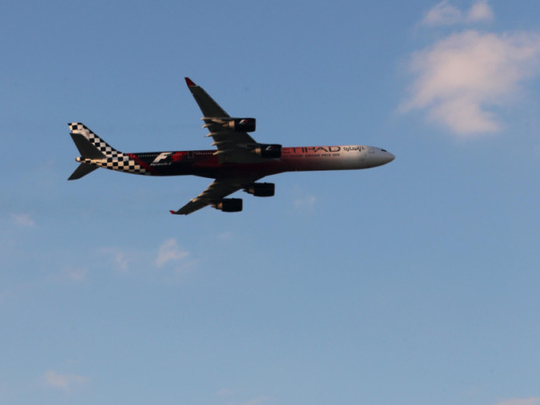
Settling into the rhythm of his ten-minute speech at the recent annual financial results conference, James Hogan, CEO of the newly formed Etihad Aviation Group, wore a knowing smile and his tone began to swagger, marked by the bass Australian accent familiar in aviation circles.
The 57-year-old Melbourne-born chief executive was announcing his airline’s third consecutive year of eyebrow-raising profits and revenues in ten years of operation. And the results for 2013 are Etihad’s best to date. Last year, the UAE’s national carrier posted a record net profit of $62 million (around Dh227.7 million) — up 48 per cent from $42 million in 2012; partnership revenues of $820 million and revenues of $6 billion. To put these numbers in perspective, Etihad was earning just $300 million in revenues in 2005.
The numbers certainly represent an “extraordinary tale of growth”, as Hogan puts it. But perhaps the most satisfying component of all of the astronomical figures flying around the Etihad Auditorium at the beginning of March is the fact that the much-scrutinised equity alliance model is beginning to pay dividends for Hogan’s team. According to recent reports, Air Berlin, which is almost 30 per cent owned by Etihad, will be delisted with Etihad raising its stakes in the airline to 49.9 per cent.
Etihad now holds minority shares in seven airlines: Air Serbia, Air Seychelles, Etihad Regional, Virgin Australia, Aer Lingus, Jet Airways and Air Berlin. And that could become eight depending on the conclusion of on-going talks with Italian loss-making carrier Alitalia. “The equity alliance, if one looked at the total revenue, would be the eighth-largest airline grouping in the world. Our equity relationships reflect the global map. It’s about connectivity,” says Hogan.
As the Etihad Group CEO enumerates the destinations and connections made possible through the equity partners, it becomes a physical effort — such is the exhaustive nature of Etihad’s footprint today.
But the airline’s approach has its critics. Neighbouring competitor Qatar Airways’ CEO, Akbar Al Baker, says that the carrier prefers to buy aircraft rather than airlines to fuel its organic growth ambitions, hinting at what he sees is Etihad’s lack of organic growth.
Disruptive innovation
Brendan Sobie, Chief Analyst, for Singapore-based Centre for Aviation, says: “Some of the scepticism in Etihad’s method may be justified, but is more really about rivals thinking their strategy is better, as you would expect [from] competitors. It will take some time to bed down and really assess the results. But for now, I think we need to give Etihad credit for trying new things and not being afraid to disrupt the status quo.”
Some industry commentators have wondered about the wisdom behind buying up cash-strapped carriers and questioned its long-term sustainability. Some have even gone as far as to besmirch Etihad as charity for ailing airlines. Hogan et al. have responded in the best possible way by letting the numbers do the talking.
Alan Peaford, Editor of Arabian Aerospace, who has followed Etihad’s growth since its inception, tells GN Focus in an emailed statement that Etihad’s financial results are a good sign in the immediacy, but time will be the true measure of its success. “Etihad’s financial results speak for themselves. The investments were made on a commercial basis and so far appear to be working,” he says.
“The danger for Etihad is whether or not its involvement and access to additional markets will stem the losses that led to the foreign airlines needing the cash in the first place. Airlines such as airberlin will require more investment. Whether that is charity or a sound financial investment will only be known over the next decade,” he adds.
It would be wrong to suggest that Etihad has ignored organic growth. The number of aircraft on order is testimony to its confidence in its ability to grow more naturally. And its increased buying power has seen some of the partner airlines benefit directly from access to new aircraft, which has, in turn, acted as a driver for their own opportunities to grow their domestic markets.
Changed thinking
Whether Etihad’s growth is labelled organic or not — although the airline will certainly insist that this is the case — one thing is certain, the thinking of European carriers has changed. Previously Gulf-sceptic regions are now embracing the business potential Etihad as well as the other two big Arab carriers are bringing to the table.
“What we have certainly discovered during the past five years is that initially, when we met with all the alliances, there was a mistrust of the Gulf airlines,” says Hogan.
“When we realised that the alliances didn’t want to talk to us in conversation with other airline CEOs, what was clear was the medium and smaller airlines felt that they’d lost their voice. And in fact what we are now seeing is that the alliances are loosening their rules because when Air France and KLM came to see us in Abu Dhabi, we walked the canvas with them, we showed them the business model, shared the books with them, so all those myths — free fuel, government guarantees, cheap labour — we were able to take off the table.
“But more importantly, as we’ve gone through the codeshare relationship we were able to deliver value to each other and that’s probably been the key step change,” says Hogan.
Commenting on the change in attitude towards Gulf carriers, Etihad particularly, Peaford says there has been a need for consolidation in the industry for a number of years with some airlines suffering financially as they chase the same routes.
“As world markets have tightened, shareholders have been far more open to minority investments that inject cash and access to new routes. Etihad has recognised this and developed a model that has been acceptable to shareholders, or governments, and has taken advantage of the opportunity.”







